Strategic Analysis of Tesco: Competitive Advantage and Growth
VerifiedAdded on 2023/06/08
|14
|4317
|135
Report
AI Summary
This report provides a comprehensive analysis of Tesco's business strategy, utilizing frameworks such as PESTLE and SWOT to evaluate the company's external environment and internal capabilities. It critically assesses Tesco's competitive advantages, including its market share, diversified store formats, and global presence, while also acknowledging weaknesses such as low-cost strategy impacts and operational challenges in certain markets. The analysis incorporates Porter's Five Forces to understand the competitive landscape, highlighting the bargaining power of buyers and suppliers, the threat of new entrants and substitutes, and the intensity of rivalry among existing competitors. Furthermore, the report identifies existing and potential competitive advantages, such as a strong human resources team, effective communication, innovation, and customer service. It concludes by devising valid and tactical objectives to achieve strategic goals, focusing on increasing sales, minimizing prices, and maintaining market dominance through cost leadership and global strategies. This detailed analysis offers valuable insights into Tesco's strategic positioning and potential avenues for growth and success.
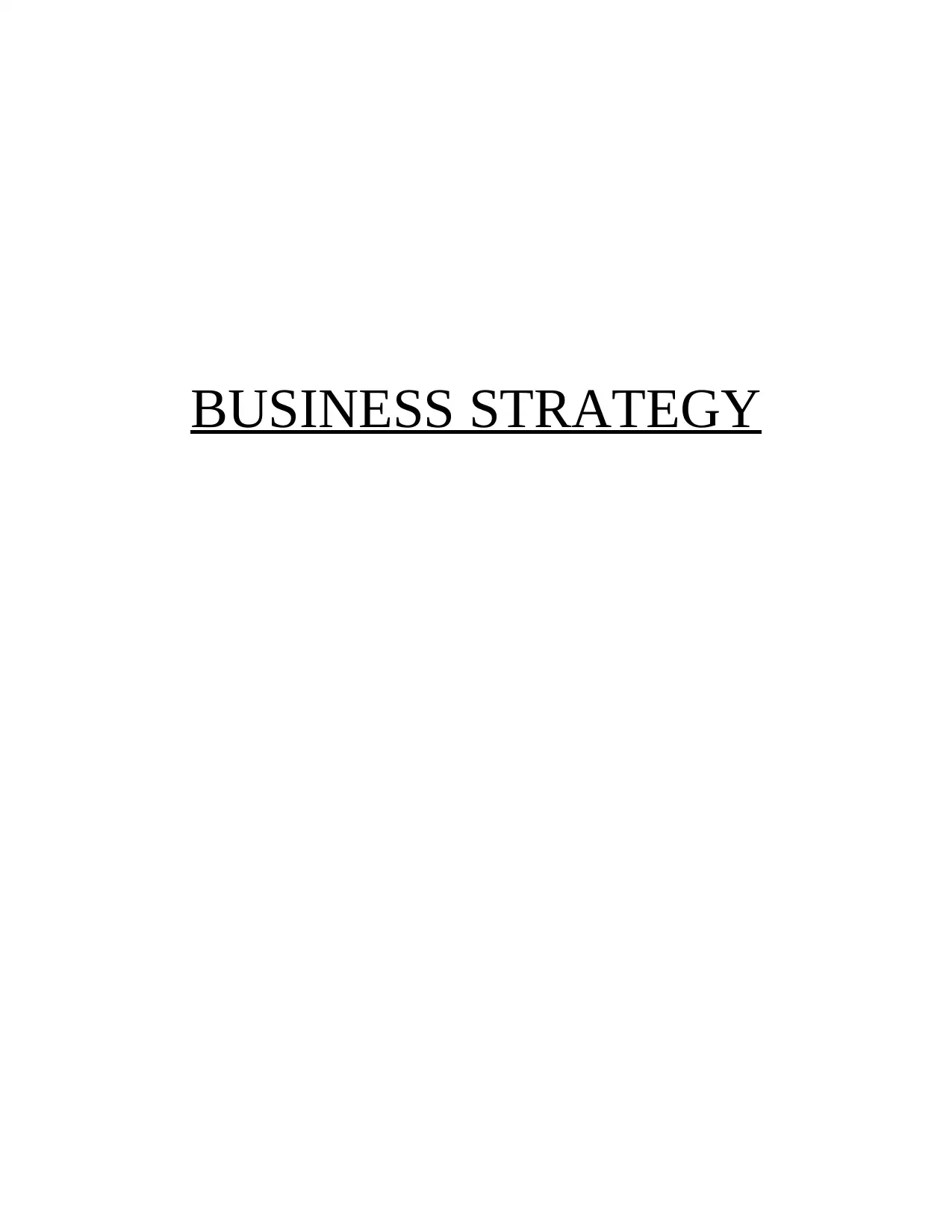
BUSINESS STRATEGY
Paraphrase This Document
Need a fresh take? Get an instant paraphrase of this document with our AI Paraphraser

TABLE OF CONTENTS
INTRODUCTION...........................................................................................................................3
MAIN BODY...................................................................................................................................3
PART A...........................................................................................................................................3
1. PESTLE and SWOT of the company and evaluation of business capabilities and resources 3
2. Critically evaluation competitive advantages of the company................................................6
3. company existing and potential competitive advantages.........................................................7
Devise valid as well as tactical objective to achieve their strategic objective.............................7
PART –B..........................................................................................................................................9
1.1 Critically evaluating the different strategic direction available to the TESCO-....................9
1.2 Justifying and recommending the most appropriate growth platform for the TESCO-......10
1.3 Evaluating the ways and means by which the TESCO can monitor the chosen strategy to
ensure success in the market......................................................................................................11
CONCLUSION..............................................................................................................................12
REFERENCES..............................................................................................................................13
INTRODUCTION...........................................................................................................................3
MAIN BODY...................................................................................................................................3
PART A...........................................................................................................................................3
1. PESTLE and SWOT of the company and evaluation of business capabilities and resources 3
2. Critically evaluation competitive advantages of the company................................................6
3. company existing and potential competitive advantages.........................................................7
Devise valid as well as tactical objective to achieve their strategic objective.............................7
PART –B..........................................................................................................................................9
1.1 Critically evaluating the different strategic direction available to the TESCO-....................9
1.2 Justifying and recommending the most appropriate growth platform for the TESCO-......10
1.3 Evaluating the ways and means by which the TESCO can monitor the chosen strategy to
ensure success in the market......................................................................................................11
CONCLUSION..............................................................................................................................12
REFERENCES..............................................................................................................................13
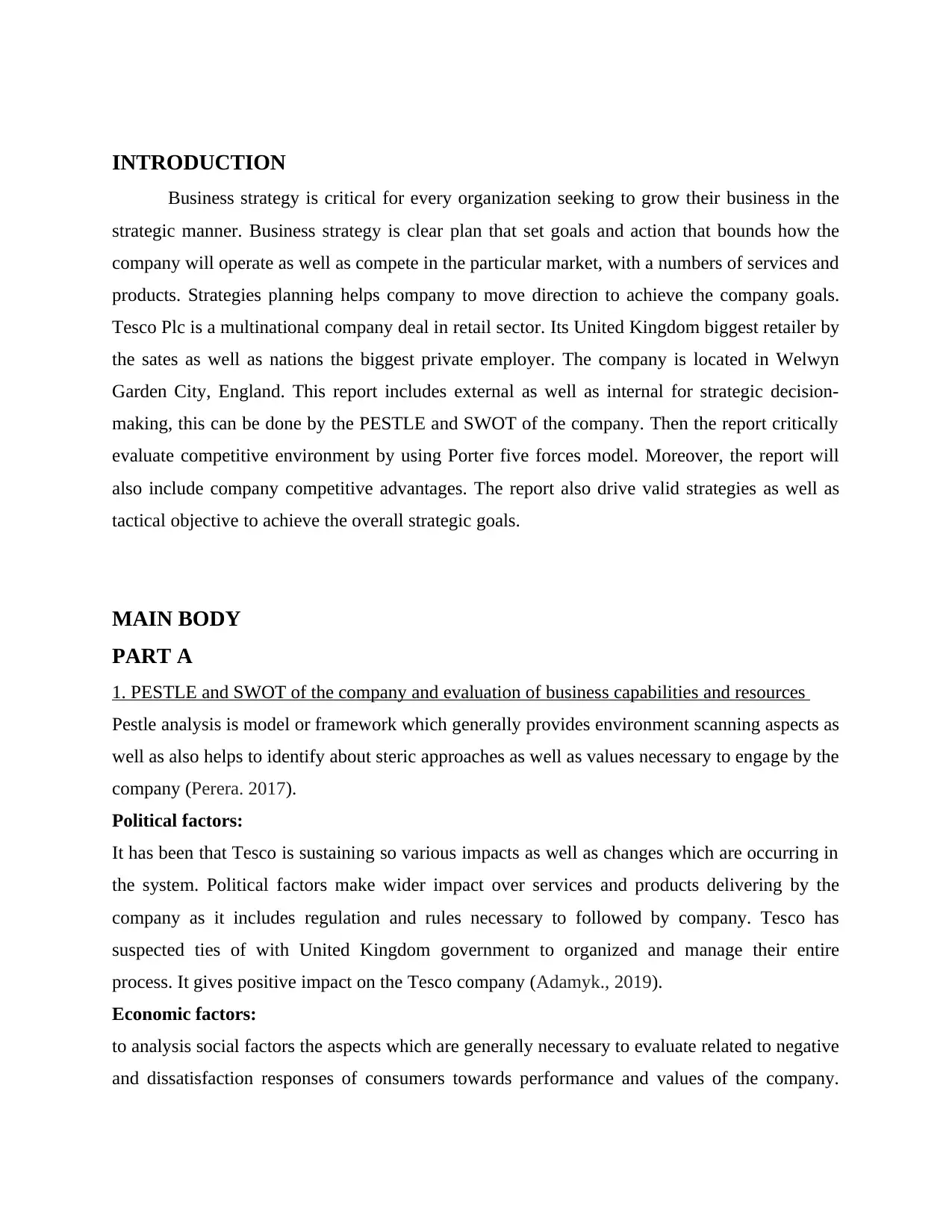
INTRODUCTION
Business strategy is critical for every organization seeking to grow their business in the
strategic manner. Business strategy is clear plan that set goals and action that bounds how the
company will operate as well as compete in the particular market, with a numbers of services and
products. Strategies planning helps company to move direction to achieve the company goals.
Tesco Plc is a multinational company deal in retail sector. Its United Kingdom biggest retailer by
the sates as well as nations the biggest private employer. The company is located in Welwyn
Garden City, England. This report includes external as well as internal for strategic decision-
making, this can be done by the PESTLE and SWOT of the company. Then the report critically
evaluate competitive environment by using Porter five forces model. Moreover, the report will
also include company competitive advantages. The report also drive valid strategies as well as
tactical objective to achieve the overall strategic goals.
MAIN BODY
PART A
1. PESTLE and SWOT of the company and evaluation of business capabilities and resources
Pestle analysis is model or framework which generally provides environment scanning aspects as
well as also helps to identify about steric approaches as well as values necessary to engage by the
company (Perera. 2017).
Political factors:
It has been that Tesco is sustaining so various impacts as well as changes which are occurring in
the system. Political factors make wider impact over services and products delivering by the
company as it includes regulation and rules necessary to followed by company. Tesco has
suspected ties of with United Kingdom government to organized and manage their entire
process. It gives positive impact on the Tesco company (Adamyk., 2019).
Economic factors:
to analysis social factors the aspects which are generally necessary to evaluate related to negative
and dissatisfaction responses of consumers towards performance and values of the company.
Business strategy is critical for every organization seeking to grow their business in the
strategic manner. Business strategy is clear plan that set goals and action that bounds how the
company will operate as well as compete in the particular market, with a numbers of services and
products. Strategies planning helps company to move direction to achieve the company goals.
Tesco Plc is a multinational company deal in retail sector. Its United Kingdom biggest retailer by
the sates as well as nations the biggest private employer. The company is located in Welwyn
Garden City, England. This report includes external as well as internal for strategic decision-
making, this can be done by the PESTLE and SWOT of the company. Then the report critically
evaluate competitive environment by using Porter five forces model. Moreover, the report will
also include company competitive advantages. The report also drive valid strategies as well as
tactical objective to achieve the overall strategic goals.
MAIN BODY
PART A
1. PESTLE and SWOT of the company and evaluation of business capabilities and resources
Pestle analysis is model or framework which generally provides environment scanning aspects as
well as also helps to identify about steric approaches as well as values necessary to engage by the
company (Perera. 2017).
Political factors:
It has been that Tesco is sustaining so various impacts as well as changes which are occurring in
the system. Political factors make wider impact over services and products delivering by the
company as it includes regulation and rules necessary to followed by company. Tesco has
suspected ties of with United Kingdom government to organized and manage their entire
process. It gives positive impact on the Tesco company (Adamyk., 2019).
Economic factors:
to analysis social factors the aspects which are generally necessary to evaluate related to negative
and dissatisfaction responses of consumers towards performance and values of the company.
⊘ This is a preview!⊘
Do you want full access?
Subscribe today to unlock all pages.

Trusted by 1+ million students worldwide
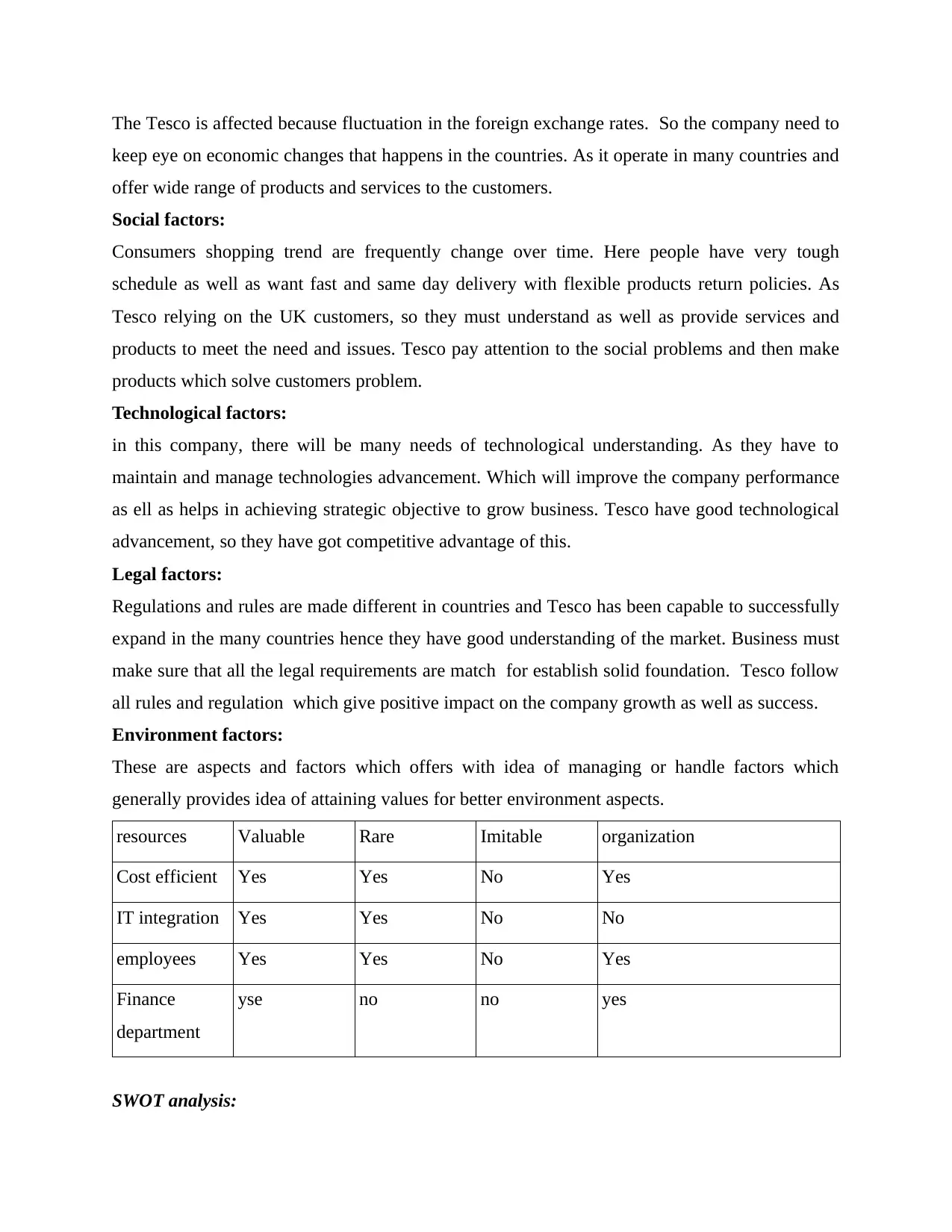
The Tesco is affected because fluctuation in the foreign exchange rates. So the company need to
keep eye on economic changes that happens in the countries. As it operate in many countries and
offer wide range of products and services to the customers.
Social factors:
Consumers shopping trend are frequently change over time. Here people have very tough
schedule as well as want fast and same day delivery with flexible products return policies. As
Tesco relying on the UK customers, so they must understand as well as provide services and
products to meet the need and issues. Tesco pay attention to the social problems and then make
products which solve customers problem.
Technological factors:
in this company, there will be many needs of technological understanding. As they have to
maintain and manage technologies advancement. Which will improve the company performance
as ell as helps in achieving strategic objective to grow business. Tesco have good technological
advancement, so they have got competitive advantage of this.
Legal factors:
Regulations and rules are made different in countries and Tesco has been capable to successfully
expand in the many countries hence they have good understanding of the market. Business must
make sure that all the legal requirements are match for establish solid foundation. Tesco follow
all rules and regulation which give positive impact on the company growth as well as success.
Environment factors:
These are aspects and factors which offers with idea of managing or handle factors which
generally provides idea of attaining values for better environment aspects.
resources Valuable Rare Imitable organization
Cost efficient Yes Yes No Yes
IT integration Yes Yes No No
employees Yes Yes No Yes
Finance
department
yse no no yes
SWOT analysis:
keep eye on economic changes that happens in the countries. As it operate in many countries and
offer wide range of products and services to the customers.
Social factors:
Consumers shopping trend are frequently change over time. Here people have very tough
schedule as well as want fast and same day delivery with flexible products return policies. As
Tesco relying on the UK customers, so they must understand as well as provide services and
products to meet the need and issues. Tesco pay attention to the social problems and then make
products which solve customers problem.
Technological factors:
in this company, there will be many needs of technological understanding. As they have to
maintain and manage technologies advancement. Which will improve the company performance
as ell as helps in achieving strategic objective to grow business. Tesco have good technological
advancement, so they have got competitive advantage of this.
Legal factors:
Regulations and rules are made different in countries and Tesco has been capable to successfully
expand in the many countries hence they have good understanding of the market. Business must
make sure that all the legal requirements are match for establish solid foundation. Tesco follow
all rules and regulation which give positive impact on the company growth as well as success.
Environment factors:
These are aspects and factors which offers with idea of managing or handle factors which
generally provides idea of attaining values for better environment aspects.
resources Valuable Rare Imitable organization
Cost efficient Yes Yes No Yes
IT integration Yes Yes No No
employees Yes Yes No Yes
Finance
department
yse no no yes
SWOT analysis:
Paraphrase This Document
Need a fresh take? Get an instant paraphrase of this document with our AI Paraphraser
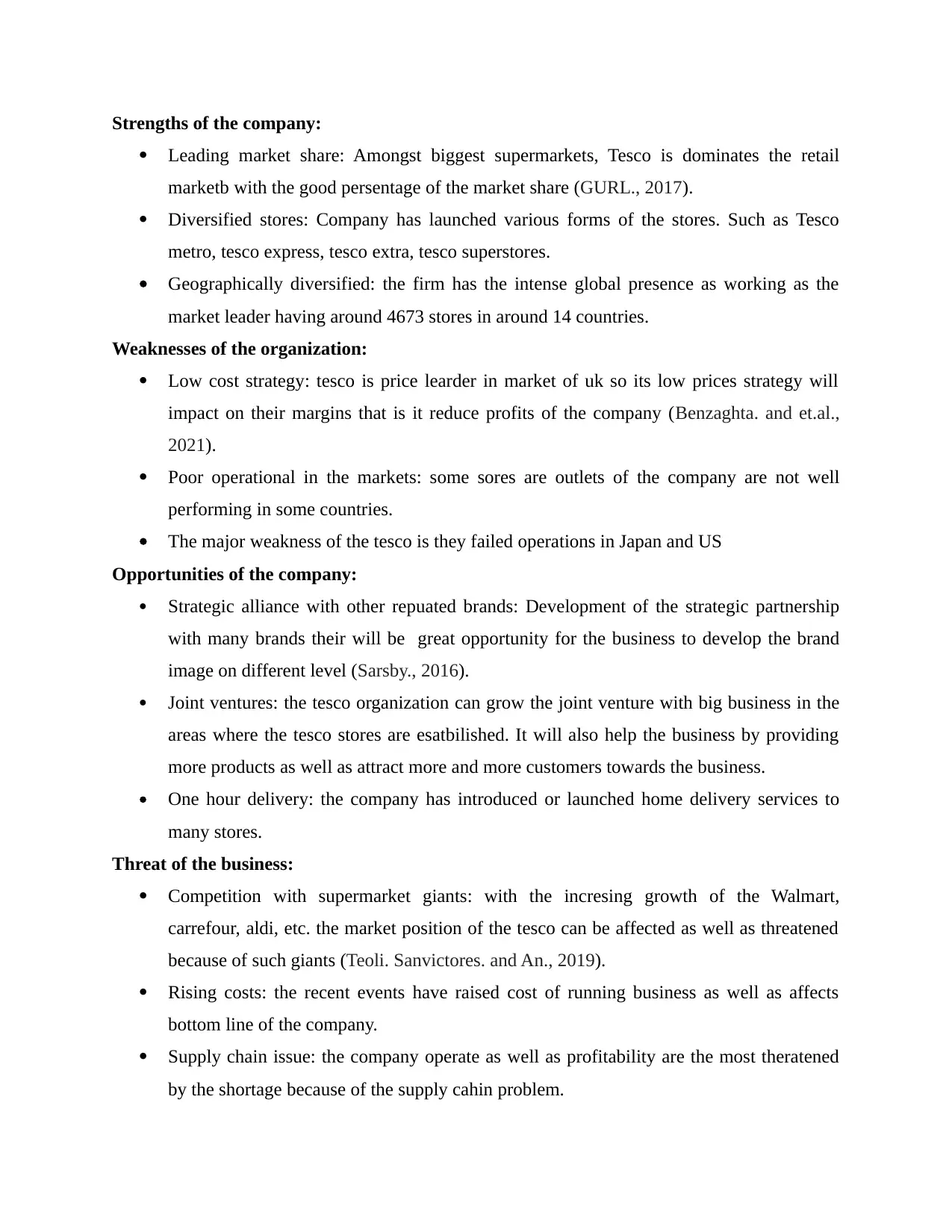
Strengths of the company:
Leading market share: Amongst biggest supermarkets, Tesco is dominates the retail
marketb with the good persentage of the market share (GURL., 2017).
Diversified stores: Company has launched various forms of the stores. Such as Tesco
metro, tesco express, tesco extra, tesco superstores.
Geographically diversified: the firm has the intense global presence as working as the
market leader having around 4673 stores in around 14 countries.
Weaknesses of the organization:
Low cost strategy: tesco is price learder in market of uk so its low prices strategy will
impact on their margins that is it reduce profits of the company (Benzaghta. and et.al.,
2021).
Poor operational in the markets: some sores are outlets of the company are not well
performing in some countries.
The major weakness of the tesco is they failed operations in Japan and US
Opportunities of the company:
Strategic alliance with other repuated brands: Development of the strategic partnership
with many brands their will be great opportunity for the business to develop the brand
image on different level (Sarsby., 2016).
Joint ventures: the tesco organization can grow the joint venture with big business in the
areas where the tesco stores are esatbilished. It will also help the business by providing
more products as well as attract more and more customers towards the business.
One hour delivery: the company has introduced or launched home delivery services to
many stores.
Threat of the business:
Competition with supermarket giants: with the incresing growth of the Walmart,
carrefour, aldi, etc. the market position of the tesco can be affected as well as threatened
because of such giants (Teoli. Sanvictores. and An., 2019).
Rising costs: the recent events have raised cost of running business as well as affects
bottom line of the company.
Supply chain issue: the company operate as well as profitability are the most theratened
by the shortage because of the supply cahin problem.
Leading market share: Amongst biggest supermarkets, Tesco is dominates the retail
marketb with the good persentage of the market share (GURL., 2017).
Diversified stores: Company has launched various forms of the stores. Such as Tesco
metro, tesco express, tesco extra, tesco superstores.
Geographically diversified: the firm has the intense global presence as working as the
market leader having around 4673 stores in around 14 countries.
Weaknesses of the organization:
Low cost strategy: tesco is price learder in market of uk so its low prices strategy will
impact on their margins that is it reduce profits of the company (Benzaghta. and et.al.,
2021).
Poor operational in the markets: some sores are outlets of the company are not well
performing in some countries.
The major weakness of the tesco is they failed operations in Japan and US
Opportunities of the company:
Strategic alliance with other repuated brands: Development of the strategic partnership
with many brands their will be great opportunity for the business to develop the brand
image on different level (Sarsby., 2016).
Joint ventures: the tesco organization can grow the joint venture with big business in the
areas where the tesco stores are esatbilished. It will also help the business by providing
more products as well as attract more and more customers towards the business.
One hour delivery: the company has introduced or launched home delivery services to
many stores.
Threat of the business:
Competition with supermarket giants: with the incresing growth of the Walmart,
carrefour, aldi, etc. the market position of the tesco can be affected as well as threatened
because of such giants (Teoli. Sanvictores. and An., 2019).
Rising costs: the recent events have raised cost of running business as well as affects
bottom line of the company.
Supply chain issue: the company operate as well as profitability are the most theratened
by the shortage because of the supply cahin problem.

2. Critically evaluation competitive advantages of the company
Bargaining power of buyers of the company
the tesco serves many customers every week, online as well as by its stores. The bargaining
power of the customers is low in the United Kingdom as they are not well organized. It is
unlikely which they can better off they switched to the competitors like sainsbury, Asda. So this
makes industry more attractive for the Tesco. Whereas, analysis argue that the power of grocery
customers is very high in UK as today their are many retailers such as Aldi, Lidl etc. Vying for
same customers, as well as compare to the Tesco company some of them are offer products at
low price. This requireds company to keep their prices low as they can so it impact on profit
margins (Bruijl. and Gerard., 2018).
Bargaining power of suppliers:
As Tesco company works with 2500 plus suppliers in United Kingdom. And many moere in the
world. So these suppliers cannot exert important power on Tesco as there are many out of them is
there. As Tesco negotiates hard with their suppliers to increase their profits margins. But, it
should mentained that organization has been accused by some bullying suppliers over price cuts.
Threat of the new entrants:
the biggest threat of the new entrants are coming into United Kigdom supermarket industry is
low generally due to capital requirements. The organization does not required to worry about
new entrance thus it enjoy economic scale as well as has its own core or effective competencies.
Threat of the substitution services and products affecting company
as the tesco company provides its customers a good range of the products and service. Company
also sells majority of producrts as substitutes products. However example is they selld margarine
as well as better. Likewise, company also sells condensed milk, freash milk, and powder milk
etc. Therefore, its easy to argue that substitute services and products as threar for tesco is
irrelevent.
Rivalry amoung company existing competitors:
the company has volume of competitors in the United Kingdom. These competitors spent various
advertising as well as other marketing tools to cove whole market. Though tesco is an market
leader, here the pressure from rivals is intense. Similarlly, price wars introduced by Lidl and Aldi
are affecting company profit margins.
Bargaining power of buyers of the company
the tesco serves many customers every week, online as well as by its stores. The bargaining
power of the customers is low in the United Kingdom as they are not well organized. It is
unlikely which they can better off they switched to the competitors like sainsbury, Asda. So this
makes industry more attractive for the Tesco. Whereas, analysis argue that the power of grocery
customers is very high in UK as today their are many retailers such as Aldi, Lidl etc. Vying for
same customers, as well as compare to the Tesco company some of them are offer products at
low price. This requireds company to keep their prices low as they can so it impact on profit
margins (Bruijl. and Gerard., 2018).
Bargaining power of suppliers:
As Tesco company works with 2500 plus suppliers in United Kingdom. And many moere in the
world. So these suppliers cannot exert important power on Tesco as there are many out of them is
there. As Tesco negotiates hard with their suppliers to increase their profits margins. But, it
should mentained that organization has been accused by some bullying suppliers over price cuts.
Threat of the new entrants:
the biggest threat of the new entrants are coming into United Kigdom supermarket industry is
low generally due to capital requirements. The organization does not required to worry about
new entrance thus it enjoy economic scale as well as has its own core or effective competencies.
Threat of the substitution services and products affecting company
as the tesco company provides its customers a good range of the products and service. Company
also sells majority of producrts as substitutes products. However example is they selld margarine
as well as better. Likewise, company also sells condensed milk, freash milk, and powder milk
etc. Therefore, its easy to argue that substitute services and products as threar for tesco is
irrelevent.
Rivalry amoung company existing competitors:
the company has volume of competitors in the United Kingdom. These competitors spent various
advertising as well as other marketing tools to cove whole market. Though tesco is an market
leader, here the pressure from rivals is intense. Similarlly, price wars introduced by Lidl and Aldi
are affecting company profit margins.
⊘ This is a preview!⊘
Do you want full access?
Subscribe today to unlock all pages.

Trusted by 1+ million students worldwide
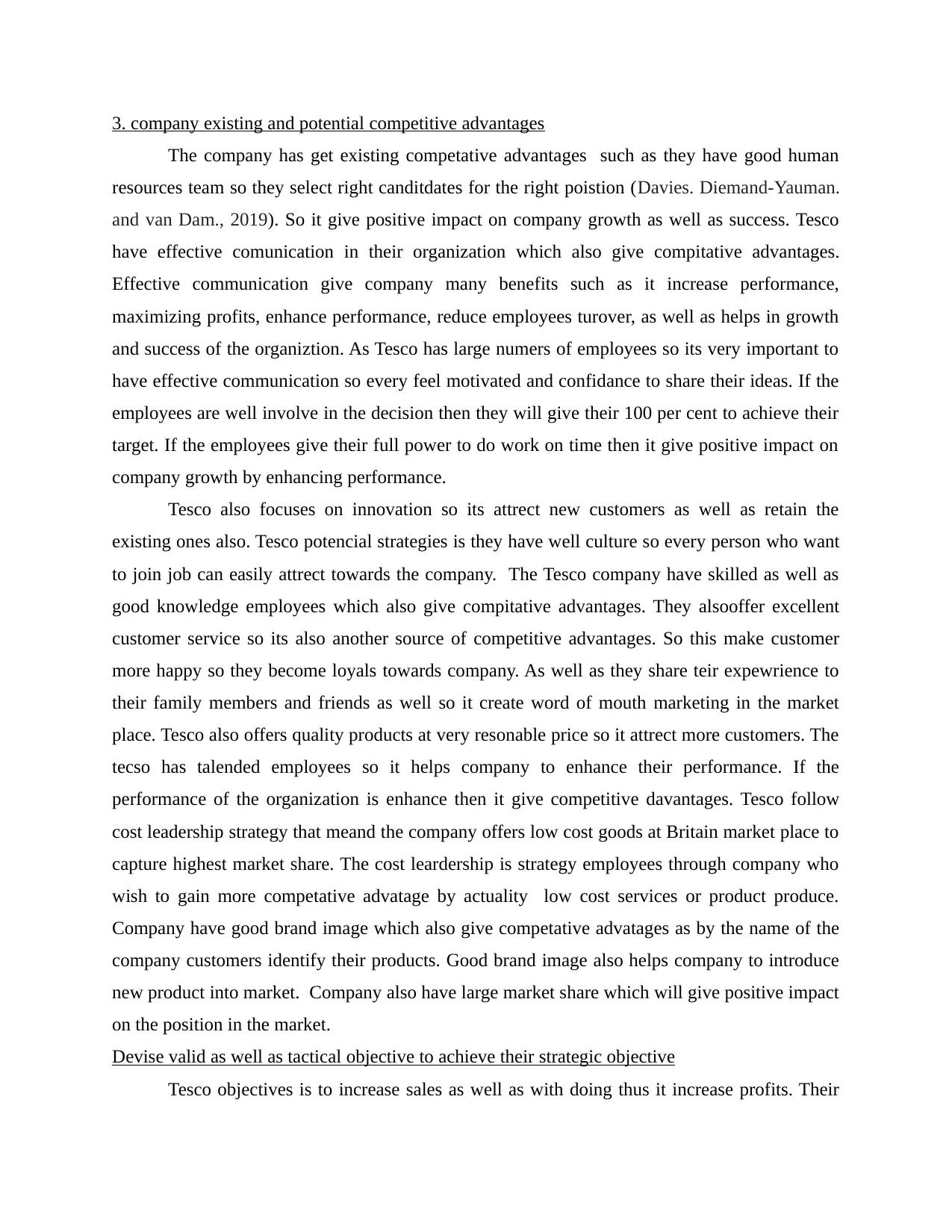
3. company existing and potential competitive advantages
The company has get existing competative advantages such as they have good human
resources team so they select right canditdates for the right poistion (Davies. Diemand-Yauman.
and van Dam., 2019). So it give positive impact on company growth as well as success. Tesco
have effective comunication in their organization which also give compitative advantages.
Effective communication give company many benefits such as it increase performance,
maximizing profits, enhance performance, reduce employees turover, as well as helps in growth
and success of the organiztion. As Tesco has large numers of employees so its very important to
have effective communication so every feel motivated and confidance to share their ideas. If the
employees are well involve in the decision then they will give their 100 per cent to achieve their
target. If the employees give their full power to do work on time then it give positive impact on
company growth by enhancing performance.
Tesco also focuses on innovation so its attrect new customers as well as retain the
existing ones also. Tesco potencial strategies is they have well culture so every person who want
to join job can easily attrect towards the company. The Tesco company have skilled as well as
good knowledge employees which also give compitative advantages. They alsooffer excellent
customer service so its also another source of competitive advantages. So this make customer
more happy so they become loyals towards company. As well as they share teir expewrience to
their family members and friends as well so it create word of mouth marketing in the market
place. Tesco also offers quality products at very resonable price so it attrect more customers. The
tecso has talended employees so it helps company to enhance their performance. If the
performance of the organization is enhance then it give competitive davantages. Tesco follow
cost leadership strategy that meand the company offers low cost goods at Britain market place to
capture highest market share. The cost leardership is strategy employees through company who
wish to gain more competative advatage by actuality low cost services or product produce.
Company have good brand image which also give competative advatages as by the name of the
company customers identify their products. Good brand image also helps company to introduce
new product into market. Company also have large market share which will give positive impact
on the position in the market.
Devise valid as well as tactical objective to achieve their strategic objective
Tesco objectives is to increase sales as well as with doing thus it increase profits. Their
The company has get existing competative advantages such as they have good human
resources team so they select right canditdates for the right poistion (Davies. Diemand-Yauman.
and van Dam., 2019). So it give positive impact on company growth as well as success. Tesco
have effective comunication in their organization which also give compitative advantages.
Effective communication give company many benefits such as it increase performance,
maximizing profits, enhance performance, reduce employees turover, as well as helps in growth
and success of the organiztion. As Tesco has large numers of employees so its very important to
have effective communication so every feel motivated and confidance to share their ideas. If the
employees are well involve in the decision then they will give their 100 per cent to achieve their
target. If the employees give their full power to do work on time then it give positive impact on
company growth by enhancing performance.
Tesco also focuses on innovation so its attrect new customers as well as retain the
existing ones also. Tesco potencial strategies is they have well culture so every person who want
to join job can easily attrect towards the company. The Tesco company have skilled as well as
good knowledge employees which also give compitative advantages. They alsooffer excellent
customer service so its also another source of competitive advantages. So this make customer
more happy so they become loyals towards company. As well as they share teir expewrience to
their family members and friends as well so it create word of mouth marketing in the market
place. Tesco also offers quality products at very resonable price so it attrect more customers. The
tecso has talended employees so it helps company to enhance their performance. If the
performance of the organization is enhance then it give competitive davantages. Tesco follow
cost leadership strategy that meand the company offers low cost goods at Britain market place to
capture highest market share. The cost leardership is strategy employees through company who
wish to gain more competative advatage by actuality low cost services or product produce.
Company have good brand image which also give competative advatages as by the name of the
company customers identify their products. Good brand image also helps company to introduce
new product into market. Company also have large market share which will give positive impact
on the position in the market.
Devise valid as well as tactical objective to achieve their strategic objective
Tesco objectives is to increase sales as well as with doing thus it increase profits. Their
Paraphrase This Document
Need a fresh take? Get an instant paraphrase of this document with our AI Paraphraser
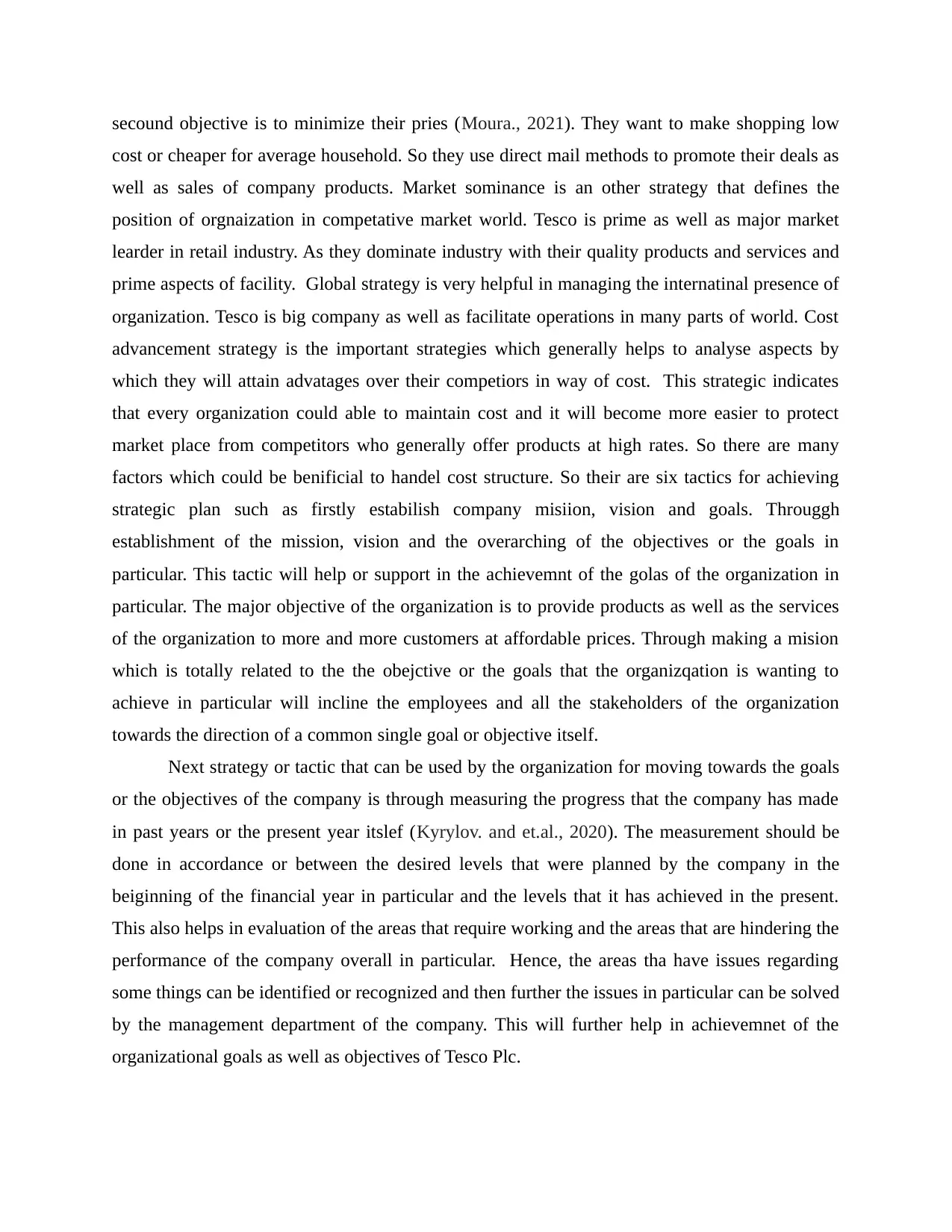
secound objective is to minimize their pries (Moura., 2021). They want to make shopping low
cost or cheaper for average household. So they use direct mail methods to promote their deals as
well as sales of company products. Market sominance is an other strategy that defines the
position of orgnaization in competative market world. Tesco is prime as well as major market
learder in retail industry. As they dominate industry with their quality products and services and
prime aspects of facility. Global strategy is very helpful in managing the internatinal presence of
organization. Tesco is big company as well as facilitate operations in many parts of world. Cost
advancement strategy is the important strategies which generally helps to analyse aspects by
which they will attain advatages over their competiors in way of cost. This strategic indicates
that every organization could able to maintain cost and it will become more easier to protect
market place from competitors who generally offer products at high rates. So there are many
factors which could be benificial to handel cost structure. So their are six tactics for achieving
strategic plan such as firstly estabilish company misiion, vision and goals. Througgh
establishment of the mission, vision and the overarching of the objectives or the goals in
particular. This tactic will help or support in the achievemnt of the golas of the organization in
particular. The major objective of the organization is to provide products as well as the services
of the organization to more and more customers at affordable prices. Through making a mision
which is totally related to the the obejctive or the goals that the organizqation is wanting to
achieve in particular will incline the employees and all the stakeholders of the organization
towards the direction of a common single goal or objective itself.
Next strategy or tactic that can be used by the organization for moving towards the goals
or the objectives of the company is through measuring the progress that the company has made
in past years or the present year itslef (Kyrylov. and et.al., 2020). The measurement should be
done in accordance or between the desired levels that were planned by the company in the
beiginning of the financial year in particular and the levels that it has achieved in the present.
This also helps in evaluation of the areas that require working and the areas that are hindering the
performance of the company overall in particular. Hence, the areas tha have issues regarding
some things can be identified or recognized and then further the issues in particular can be solved
by the management department of the company. This will further help in achievemnet of the
organizational goals as well as objectives of Tesco Plc.
cost or cheaper for average household. So they use direct mail methods to promote their deals as
well as sales of company products. Market sominance is an other strategy that defines the
position of orgnaization in competative market world. Tesco is prime as well as major market
learder in retail industry. As they dominate industry with their quality products and services and
prime aspects of facility. Global strategy is very helpful in managing the internatinal presence of
organization. Tesco is big company as well as facilitate operations in many parts of world. Cost
advancement strategy is the important strategies which generally helps to analyse aspects by
which they will attain advatages over their competiors in way of cost. This strategic indicates
that every organization could able to maintain cost and it will become more easier to protect
market place from competitors who generally offer products at high rates. So there are many
factors which could be benificial to handel cost structure. So their are six tactics for achieving
strategic plan such as firstly estabilish company misiion, vision and goals. Througgh
establishment of the mission, vision and the overarching of the objectives or the goals in
particular. This tactic will help or support in the achievemnt of the golas of the organization in
particular. The major objective of the organization is to provide products as well as the services
of the organization to more and more customers at affordable prices. Through making a mision
which is totally related to the the obejctive or the goals that the organizqation is wanting to
achieve in particular will incline the employees and all the stakeholders of the organization
towards the direction of a common single goal or objective itself.
Next strategy or tactic that can be used by the organization for moving towards the goals
or the objectives of the company is through measuring the progress that the company has made
in past years or the present year itslef (Kyrylov. and et.al., 2020). The measurement should be
done in accordance or between the desired levels that were planned by the company in the
beiginning of the financial year in particular and the levels that it has achieved in the present.
This also helps in evaluation of the areas that require working and the areas that are hindering the
performance of the company overall in particular. Hence, the areas tha have issues regarding
some things can be identified or recognized and then further the issues in particular can be solved
by the management department of the company. This will further help in achievemnet of the
organizational goals as well as objectives of Tesco Plc.
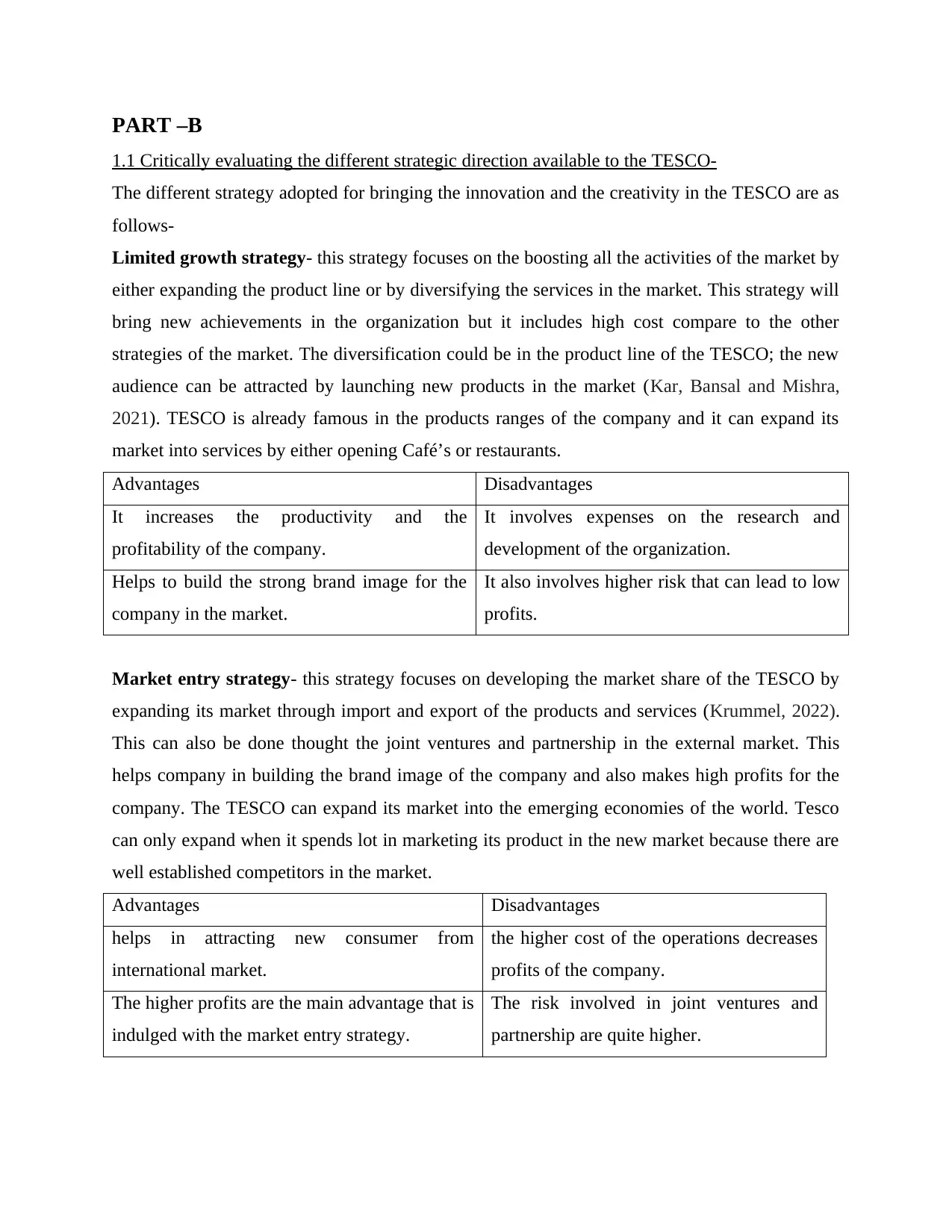
PART –B
1.1 Critically evaluating the different strategic direction available to the TESCO-
The different strategy adopted for bringing the innovation and the creativity in the TESCO are as
follows-
Limited growth strategy- this strategy focuses on the boosting all the activities of the market by
either expanding the product line or by diversifying the services in the market. This strategy will
bring new achievements in the organization but it includes high cost compare to the other
strategies of the market. The diversification could be in the product line of the TESCO; the new
audience can be attracted by launching new products in the market (Kar, Bansal and Mishra,
2021). TESCO is already famous in the products ranges of the company and it can expand its
market into services by either opening Café’s or restaurants.
Advantages Disadvantages
It increases the productivity and the
profitability of the company.
It involves expenses on the research and
development of the organization.
Helps to build the strong brand image for the
company in the market.
It also involves higher risk that can lead to low
profits.
Market entry strategy- this strategy focuses on developing the market share of the TESCO by
expanding its market through import and export of the products and services (Krummel, 2022).
This can also be done thought the joint ventures and partnership in the external market. This
helps company in building the brand image of the company and also makes high profits for the
company. The TESCO can expand its market into the emerging economies of the world. Tesco
can only expand when it spends lot in marketing its product in the new market because there are
well established competitors in the market.
Advantages Disadvantages
helps in attracting new consumer from
international market.
the higher cost of the operations decreases
profits of the company.
The higher profits are the main advantage that is
indulged with the market entry strategy.
The risk involved in joint ventures and
partnership are quite higher.
1.1 Critically evaluating the different strategic direction available to the TESCO-
The different strategy adopted for bringing the innovation and the creativity in the TESCO are as
follows-
Limited growth strategy- this strategy focuses on the boosting all the activities of the market by
either expanding the product line or by diversifying the services in the market. This strategy will
bring new achievements in the organization but it includes high cost compare to the other
strategies of the market. The diversification could be in the product line of the TESCO; the new
audience can be attracted by launching new products in the market (Kar, Bansal and Mishra,
2021). TESCO is already famous in the products ranges of the company and it can expand its
market into services by either opening Café’s or restaurants.
Advantages Disadvantages
It increases the productivity and the
profitability of the company.
It involves expenses on the research and
development of the organization.
Helps to build the strong brand image for the
company in the market.
It also involves higher risk that can lead to low
profits.
Market entry strategy- this strategy focuses on developing the market share of the TESCO by
expanding its market through import and export of the products and services (Krummel, 2022).
This can also be done thought the joint ventures and partnership in the external market. This
helps company in building the brand image of the company and also makes high profits for the
company. The TESCO can expand its market into the emerging economies of the world. Tesco
can only expand when it spends lot in marketing its product in the new market because there are
well established competitors in the market.
Advantages Disadvantages
helps in attracting new consumer from
international market.
the higher cost of the operations decreases
profits of the company.
The higher profits are the main advantage that is
indulged with the market entry strategy.
The risk involved in joint ventures and
partnership are quite higher.
⊘ This is a preview!⊘
Do you want full access?
Subscribe today to unlock all pages.

Trusted by 1+ million students worldwide
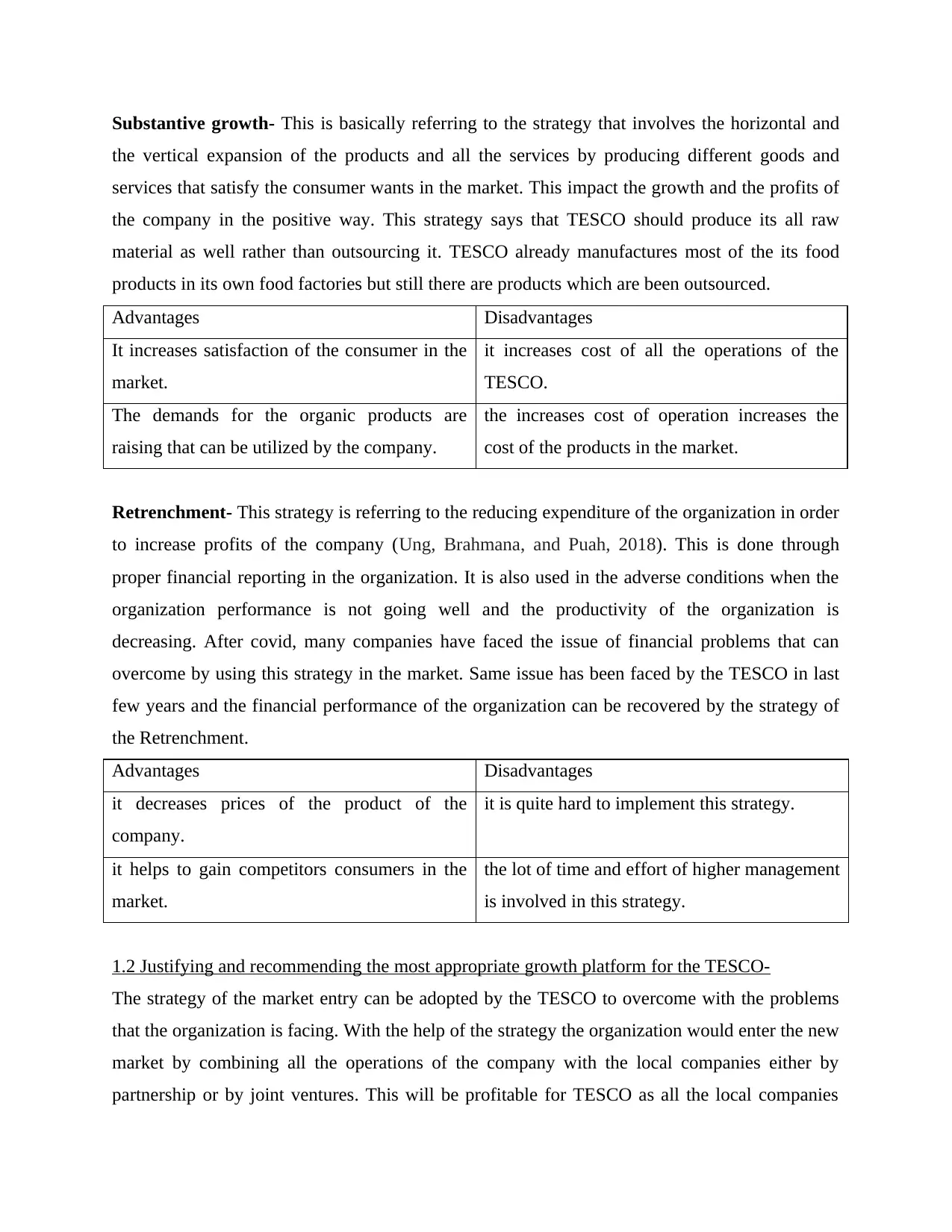
Substantive growth- This is basically referring to the strategy that involves the horizontal and
the vertical expansion of the products and all the services by producing different goods and
services that satisfy the consumer wants in the market. This impact the growth and the profits of
the company in the positive way. This strategy says that TESCO should produce its all raw
material as well rather than outsourcing it. TESCO already manufactures most of the its food
products in its own food factories but still there are products which are been outsourced.
Advantages Disadvantages
It increases satisfaction of the consumer in the
market.
it increases cost of all the operations of the
TESCO.
The demands for the organic products are
raising that can be utilized by the company.
the increases cost of operation increases the
cost of the products in the market.
Retrenchment- This strategy is referring to the reducing expenditure of the organization in order
to increase profits of the company (Ung, Brahmana, and Puah, 2018). This is done through
proper financial reporting in the organization. It is also used in the adverse conditions when the
organization performance is not going well and the productivity of the organization is
decreasing. After covid, many companies have faced the issue of financial problems that can
overcome by using this strategy in the market. Same issue has been faced by the TESCO in last
few years and the financial performance of the organization can be recovered by the strategy of
the Retrenchment.
Advantages Disadvantages
it decreases prices of the product of the
company.
it is quite hard to implement this strategy.
it helps to gain competitors consumers in the
market.
the lot of time and effort of higher management
is involved in this strategy.
1.2 Justifying and recommending the most appropriate growth platform for the TESCO-
The strategy of the market entry can be adopted by the TESCO to overcome with the problems
that the organization is facing. With the help of the strategy the organization would enter the new
market by combining all the operations of the company with the local companies either by
partnership or by joint ventures. This will be profitable for TESCO as all the local companies
the vertical expansion of the products and all the services by producing different goods and
services that satisfy the consumer wants in the market. This impact the growth and the profits of
the company in the positive way. This strategy says that TESCO should produce its all raw
material as well rather than outsourcing it. TESCO already manufactures most of the its food
products in its own food factories but still there are products which are been outsourced.
Advantages Disadvantages
It increases satisfaction of the consumer in the
market.
it increases cost of all the operations of the
TESCO.
The demands for the organic products are
raising that can be utilized by the company.
the increases cost of operation increases the
cost of the products in the market.
Retrenchment- This strategy is referring to the reducing expenditure of the organization in order
to increase profits of the company (Ung, Brahmana, and Puah, 2018). This is done through
proper financial reporting in the organization. It is also used in the adverse conditions when the
organization performance is not going well and the productivity of the organization is
decreasing. After covid, many companies have faced the issue of financial problems that can
overcome by using this strategy in the market. Same issue has been faced by the TESCO in last
few years and the financial performance of the organization can be recovered by the strategy of
the Retrenchment.
Advantages Disadvantages
it decreases prices of the product of the
company.
it is quite hard to implement this strategy.
it helps to gain competitors consumers in the
market.
the lot of time and effort of higher management
is involved in this strategy.
1.2 Justifying and recommending the most appropriate growth platform for the TESCO-
The strategy of the market entry can be adopted by the TESCO to overcome with the problems
that the organization is facing. With the help of the strategy the organization would enter the new
market by combining all the operations of the company with the local companies either by
partnership or by joint ventures. This will be profitable for TESCO as all the local companies
Paraphrase This Document
Need a fresh take? Get an instant paraphrase of this document with our AI Paraphraser
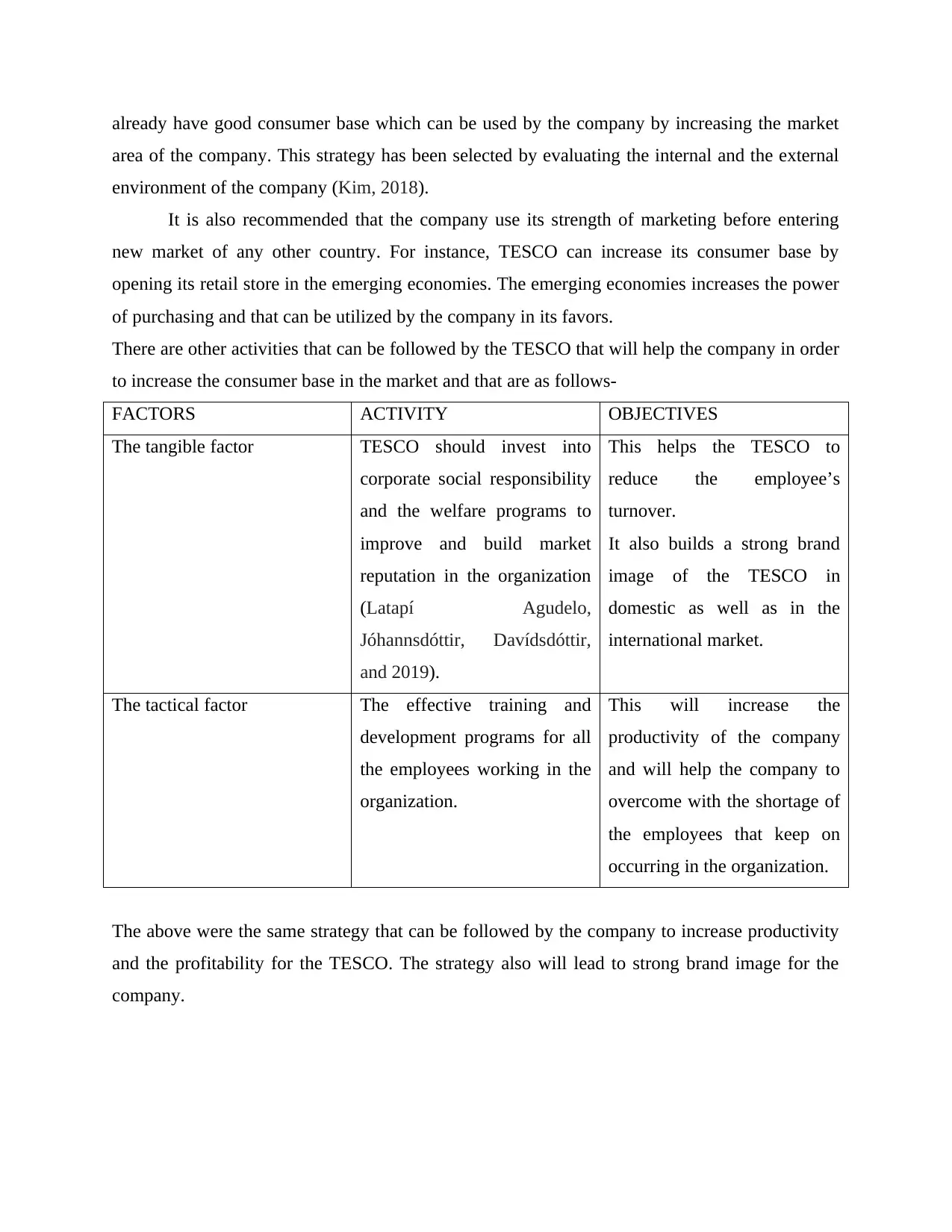
already have good consumer base which can be used by the company by increasing the market
area of the company. This strategy has been selected by evaluating the internal and the external
environment of the company (Kim, 2018).
It is also recommended that the company use its strength of marketing before entering
new market of any other country. For instance, TESCO can increase its consumer base by
opening its retail store in the emerging economies. The emerging economies increases the power
of purchasing and that can be utilized by the company in its favors.
There are other activities that can be followed by the TESCO that will help the company in order
to increase the consumer base in the market and that are as follows-
FACTORS ACTIVITY OBJECTIVES
The tangible factor TESCO should invest into
corporate social responsibility
and the welfare programs to
improve and build market
reputation in the organization
(Latapí Agudelo,
Jóhannsdóttir, Davídsdóttir,
and 2019).
This helps the TESCO to
reduce the employee’s
turnover.
It also builds a strong brand
image of the TESCO in
domestic as well as in the
international market.
The tactical factor The effective training and
development programs for all
the employees working in the
organization.
This will increase the
productivity of the company
and will help the company to
overcome with the shortage of
the employees that keep on
occurring in the organization.
The above were the same strategy that can be followed by the company to increase productivity
and the profitability for the TESCO. The strategy also will lead to strong brand image for the
company.
area of the company. This strategy has been selected by evaluating the internal and the external
environment of the company (Kim, 2018).
It is also recommended that the company use its strength of marketing before entering
new market of any other country. For instance, TESCO can increase its consumer base by
opening its retail store in the emerging economies. The emerging economies increases the power
of purchasing and that can be utilized by the company in its favors.
There are other activities that can be followed by the TESCO that will help the company in order
to increase the consumer base in the market and that are as follows-
FACTORS ACTIVITY OBJECTIVES
The tangible factor TESCO should invest into
corporate social responsibility
and the welfare programs to
improve and build market
reputation in the organization
(Latapí Agudelo,
Jóhannsdóttir, Davídsdóttir,
and 2019).
This helps the TESCO to
reduce the employee’s
turnover.
It also builds a strong brand
image of the TESCO in
domestic as well as in the
international market.
The tactical factor The effective training and
development programs for all
the employees working in the
organization.
This will increase the
productivity of the company
and will help the company to
overcome with the shortage of
the employees that keep on
occurring in the organization.
The above were the same strategy that can be followed by the company to increase productivity
and the profitability for the TESCO. The strategy also will lead to strong brand image for the
company.
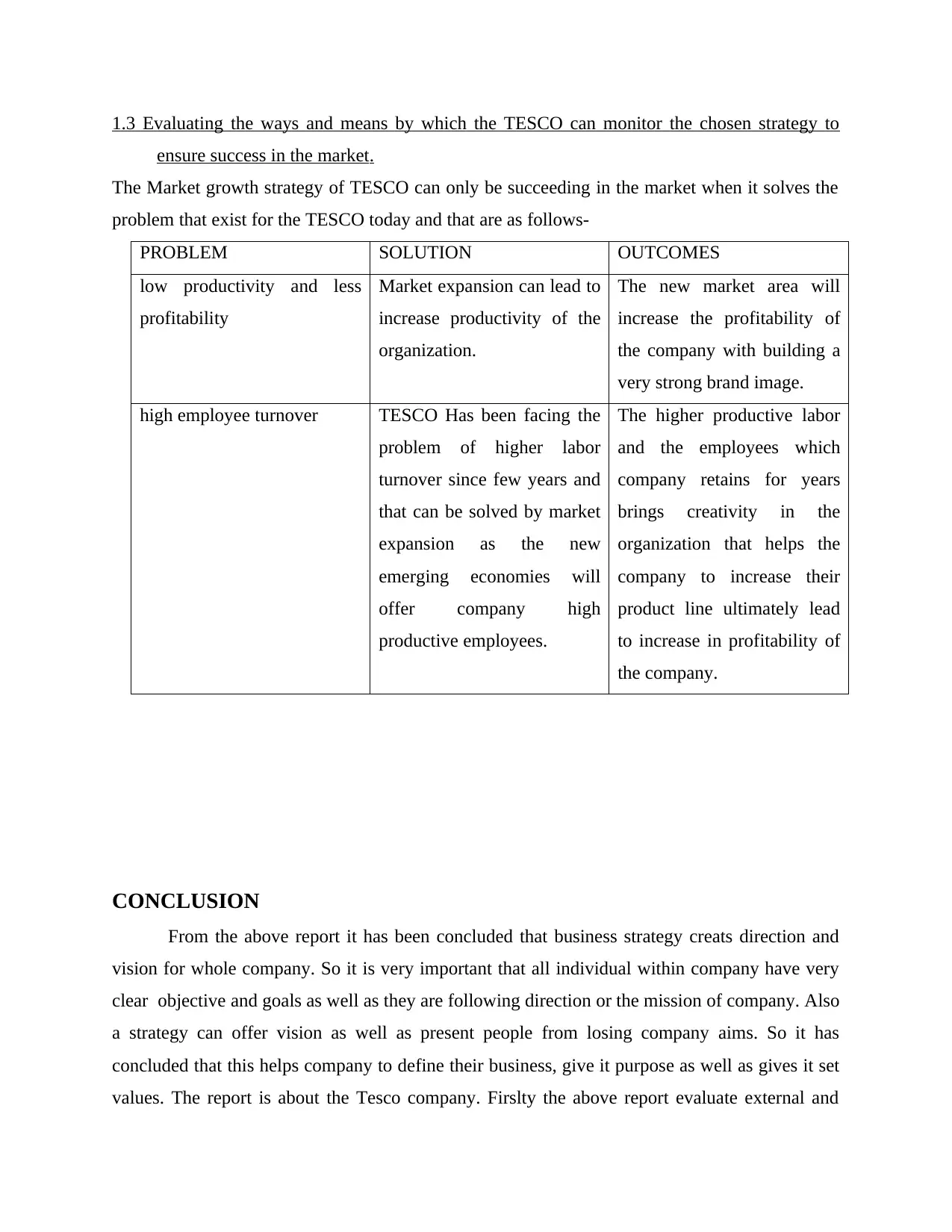
1.3 Evaluating the ways and means by which the TESCO can monitor the chosen strategy to
ensure success in the market.
The Market growth strategy of TESCO can only be succeeding in the market when it solves the
problem that exist for the TESCO today and that are as follows-
PROBLEM SOLUTION OUTCOMES
low productivity and less
profitability
Market expansion can lead to
increase productivity of the
organization.
The new market area will
increase the profitability of
the company with building a
very strong brand image.
high employee turnover TESCO Has been facing the
problem of higher labor
turnover since few years and
that can be solved by market
expansion as the new
emerging economies will
offer company high
productive employees.
The higher productive labor
and the employees which
company retains for years
brings creativity in the
organization that helps the
company to increase their
product line ultimately lead
to increase in profitability of
the company.
CONCLUSION
From the above report it has been concluded that business strategy creats direction and
vision for whole company. So it is very important that all individual within company have very
clear objective and goals as well as they are following direction or the mission of company. Also
a strategy can offer vision as well as present people from losing company aims. So it has
concluded that this helps company to define their business, give it purpose as well as gives it set
values. The report is about the Tesco company. Firslty the above report evaluate external and
ensure success in the market.
The Market growth strategy of TESCO can only be succeeding in the market when it solves the
problem that exist for the TESCO today and that are as follows-
PROBLEM SOLUTION OUTCOMES
low productivity and less
profitability
Market expansion can lead to
increase productivity of the
organization.
The new market area will
increase the profitability of
the company with building a
very strong brand image.
high employee turnover TESCO Has been facing the
problem of higher labor
turnover since few years and
that can be solved by market
expansion as the new
emerging economies will
offer company high
productive employees.
The higher productive labor
and the employees which
company retains for years
brings creativity in the
organization that helps the
company to increase their
product line ultimately lead
to increase in profitability of
the company.
CONCLUSION
From the above report it has been concluded that business strategy creats direction and
vision for whole company. So it is very important that all individual within company have very
clear objective and goals as well as they are following direction or the mission of company. Also
a strategy can offer vision as well as present people from losing company aims. So it has
concluded that this helps company to define their business, give it purpose as well as gives it set
values. The report is about the Tesco company. Firslty the above report evaluate external and
⊘ This is a preview!⊘
Do you want full access?
Subscribe today to unlock all pages.

Trusted by 1+ million students worldwide
1 out of 14
Related Documents
Your All-in-One AI-Powered Toolkit for Academic Success.
+13062052269
info@desklib.com
Available 24*7 on WhatsApp / Email
![[object Object]](/_next/static/media/star-bottom.7253800d.svg)
Unlock your academic potential
Copyright © 2020–2025 A2Z Services. All Rights Reserved. Developed and managed by ZUCOL.

